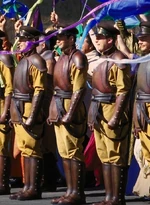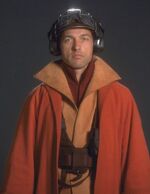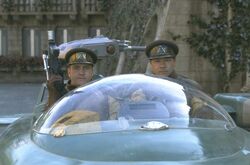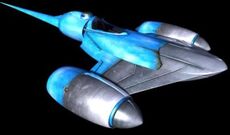| | |
Warning: This infobox has missing parameters: subgroup, type and unrecognized parameters: era, members, imageBG
- "This is a dangerous situation, Your Highness. Our security volunteers will be no match against a battle-hardened Federation army."
- ―Panaka, to Queen Amidala
The Royal Naboo Security Forces, also shortened as Royal Security Forces, or abbreviated as RSNF and RSF, were the premier line of defense for both the Theed Royal Palace and the citizens of Naboo. A peaceful people, the Naboo retained only security officers and guards, rather than a true military organization.
History
Early history
The Royal Naboo Security Forces existed after 67 BBY on the planet Naboo. Captain Maris Magneta was the head of the force under King Ars Veruna.[1] Magneta resigned after Veruna's mysterious death and was replaced by Quarsh Panaka, who instigated tighter security procedures for Queen Amidala, including decoy handmaidens.[8] The members often got off-world experience, but returned out of loyalty to serve.[9] The Security Forces were stationed in the main hangar in Theed, the capital city.
The Battle of Naboo
The Security Forces were forced into their first real battle against the organization called the Trade Federation in 32 BBY, and fought valiantly, yet in vain, against its battle droid legions during the Invasion of Naboo.[10] The Federation detained them in prison camps until some were freed by Lieutenant Gavyn Sykes, while survivors formed a portion of the resistance.[6]. The Federation established their own patrols on the planet. Queen Amidala and Captain Panaka rallied the troops upon their return to Naboo, and were able to capture the Federation's leader, Viceroy Nute Gunray, and end the droid occupation.[2] The Security Forces continued to protect Naboo following these battles, though adopted many increased security measures during the Separatist Crisis[7] and the eventual Clone Wars.
Clone Wars
Around 22 BBY,[11] Supreme Chancellor Palpatine arrived back on Naboo for the Festival of Light. The Security Forces established a defensive position around the Chancellor's Podium, but a team of bounty hunters managed to abduct the Chancellor. He was successfully rescued by the Jedi Knight Anakin Skywalker.[12]
Around that time, the ELG-3A blaster pistol was a standard-issue blaster aboard all RSF ships, including their battleships.[13]
The rise of the Empire

Royal security force during the celebration after the invasion of Naboo.
The Security Forces had to show their determination when the Galactic Empire became the new galactic order. In 19 BBY, the security guards, along with some Gungans, attacked the Imperial garrison in Theed. The object of the attack was to stop Inquisitor Malorum from transmitting a vital secret. Ultimately, ex-Jedi Ferus Olin killed the Inquisitor in the Plasma Refinery Complex, while the Royal Naboo Security Forces and the Gungan Grand Army achieved the victory in the city and in the Imperial garrison. To hide the attack an illegal weapons cache in the Theed Hangar was detonated.[14]
However, peace for the security forces was short-lived. Naboo's then-queen, Apailana, had been housing Jedi runaways fleeing from the Empire's Great Jedi Purge at her own risk. When it was ordered that Apailana be executed for treason, the Empire had prepared its elite 501st Legion of stormtroopers. The Security Forces tried their best to hold off the 501st during what was later called the Fall of Naboo. However, the Royal Palace was soon besieged. The Naboo forces were quickly beheaded without a strong leader like Panaka had once been. Auto-turrets were shut down and the grid console destroyed. Most of the security and palace fighters met their dooms. At last, Apailana was assassinated in the royal plaza in the midst of the battle.[15]
The Royal Naboo Security Forces were at last defeated, and most of the remaining survivors loyal to Apailana were quietly arrested and transported to the secret Death Star detention centers.[15]
During the Imperial Period, the Royal Naboo Security Forces owned a Mon Calamari Star Cruiser, the RNS Queen Amidala IV.[16]
The Galactic Civil War
The Queen's Royal Guard (established for the following queen, Kylantha) took the place of the once-experienced Royal Naboo Security Forces, who were relegated to being a type of police force. Rather than having many branches as the old security forces, the Royal Guard was made up of only a select few bodyguards who the monarch knew on a personal level. While the RSF continued as a small police force, protection of Naboo and its systems was mainly performed by the Imperial stormtroopers up until the rise of the New Republic.
Sometime after the Battle of Yavin, the weakened RSF police force had severe problems with the many criminal gangs that had swamped the planet after the rise of the Empire. In the employ of the RSF were people such as Harriet Brunser, Gregar Typho, Mercious Bragg, Karenna Dunnels, and Sundria Khartoor. Quarsh Panaka would on occasion delegate missions to the agents of the RSF, as would Pooja Naberrie. With no help from the Imperial garrison, the RSF had completely lost the grip on the overwhelming criminal activity. Fortunately, they were able to enlist the help of groups of unidentified travelers, whose assistance enabled the Security Forces to put a stop to many gang-related crimes, including the Skaak Tippers and the Maulers.[17]
In 4 ABY, a coalition of remaining Naboo loyalists and the Gungan Grand Army were able to openly defy the Empire. This action may have succeeded in freeing the planet from Imperial forces, just as the resistance had freed it from the Trade Federation over three decades earlier. What is known, is that Naboo joined the New Republic, being represented with a Senator once again.[source?]
Organization
The Royal Naboo Security Forces was made up of volunteers and professionals, and was split into a number of factions:
- Handmaiden: The secret service of the security forces, aiding the Monarch (if a queen) in simple duties such as getting dressed to defense duties such as the utmost protection, including hiding her among their own ranks. Along with the Queen, the Handmaidens wielded Model Q2 hold-out blaster pistols and/or ELG-3A blaster pistols.
- Palace Guard: Highly-trained bodyguards stationed in the Theed Royal Palace who acted as bodyguards to the king or queen, or even the senator. Though few in number, the Palace Guards were the backbone of the Security Forces. They wore sleek, combat helmets and red blast-dampening vests and carried S-5 heavy blaster pistols.[8] After the Battle of Naboo, they wore darker uniforms.

A RNSF fighter pilot
- Queen's Honor Guard: A group of pilots who escorted the monarch when away from Naboo.[18]
- Security Officer: The top leaders of the Security Forces, these men and women were loyal yet mostly unfamiliar to true danger. They were the paid officers who worked under the captain of Security.[8] Roughly 1,000 in number prior to the Clone Wars, they led the part-time and volunteer soldiers. They often were armed with compact, royal sporting blaster pistols and were protected by leather jerkins over a blue officer's coat. After the Battle of Naboo, they wore darker uniforms, with a different distribution of red and blue.
- Grenadier: Grenadiers were soldiers who were trained to use grenades.[19]
- Security Guard: Naboo's equivalent to a regular infantry and to police officers, who served as patrolmen and sentries in Theed. They were large in number during the Battle of Naboo and fired S-5 heavy blaster pistols and the powerpacked CR-2 heavy blaster pistols and were trained by Captain Panaka.[8] They wore flexible armor plates over a dull yellow jumpsuit. During the reign of Queen Apailana, they wore leather vests over red jumpsuits, blending them with the Palace Guards. After the Battle of Naboo, they wore darker uniforms.
- Fighter Pilot: Skilled space pilots operating in and around the Naboo system. This corps included the famed Bravo Squadron and fought in N-1 starfighters.[8] They wore long orange overcoats for warmth in space and flying helmets with visors. After the Battle of Naboo, they wore darker uniforms, and a new type of helmet.
- Royal Navy: The aquatic naval forces of the Security Force. Had a base in the city of Harte Secur.[20]
- Engineers: Engineers were personnel within the Royal Naboo Security Forces who were responsible for maintaining various vehicles and vessels on Naboo. They wore yellow jumpsuits and helmets that bore their first names in Futhork as their uniforms.
Enlisted ranks

The RNSF rank insignias ranging from RSF Private to RSF Lieutenant
During the Galactic Civil War, the Royal Naboo Security Forces were known to use at least seven distinctive ranks following the Battle of Yavin in 0 BBY.[17]
- RSF Private[17]
- RSF Lance Corporal[17]
- RSF Corporal[17]
- RSF Sergeant[17]
- RSF Master Sergeant[17]
- RSF Sergeant Major[17]
- RSF Lieutenant[17]
Army
Soldiers
- Royal Crusader[20]
- Elite Royal Crusader[20]
- Royal Kaadu Trooper[20]
- Tuskcat Trooper[21]
Droids
Vehicles
Land

Two Security Guards in a Flash speeder.
- Flash speeder[2]
- Gian speeder[2]
- Champion[20]
- Heavy Champion[20]
- Naboo commando transport[6]
- Naboo energy catapult[20]
- Steadfast[20]
Sea
- Naboo transport[20]
- Light Scout[20]
- Scout [20]
- Advanced Scout[20]
- Naboo Cruiser[20]
- Heavy Cruiser[20]
- Destroyer[20]
- Heavy Destroyer[20]
- Missile Destroyer[20]
- Heavy Missile Destroyer[20]
- Swamp speeder[6]
- Utility trawler[20]
Air/space

An N-X Police Cruiser
- Battleships[13]
- H-type Nubian yacht
- J-type diplomatic barge
- J-type 327 Nubian royal starship[2]
- J-type star skiff[7]
- Naboo Royal Lifter[20]
- N-1L Light Starfighter[20]
- N-1 starfighter[2]
- N-1T Advanced Starfighter[20]
- NB-1 Royal Bomber[20]
- NB-1S Royal Bomber[6]
- NB-1T Royal Bomber[20]
- N-X Police Cruiser[6]
- Royal air cruiser[20]
- S-130 Shelter speeder
- Mon Calamari Star Cruiser[16]
Installations

The Security Forces utilized a number of security hangars throughout Naboo.
- Harte Secur Airbase[20]
- The Naboo airbase[6]
- Resistance base hidden in the Naboo training canyon[5]
- Resistance outpost[5]
- Theed Hangar[2]
Behind the scenes
The Royal Naboo Security Forces first appeared in 1999 with the release of Star Wars: Episode I The Phantom Menace and its tie-ins.
The first hint that the Royal Naboo Security Forces possessed an aquatic fleet was in the video game Star Wars: Episode I: Battle for Naboo, which included a Swamp Speeder as an unlockable. The aquatic fleet was later completely unveiled in the game Star Wars: Galactic Battlegrounds.
The Security Forces appeared in LEGO form in the humorous retelling of the Prequel trilogy, the 2005 video game LEGO Star Wars: The Video Game and the game's 2007 compilation re-release.
Appearances
Non-canon appearances
- LEGO Star Wars: The Phantom Menace
- LEGO Star Wars: The Video Game
- LEGO Star Wars: The Complete Saga
- LEGO Star Wars: Darth Maul's Mission

